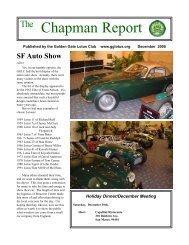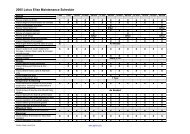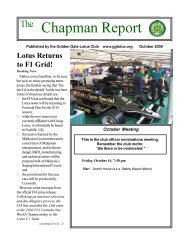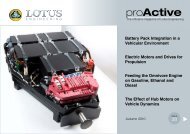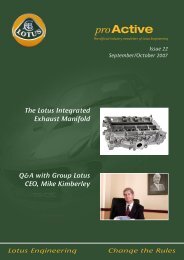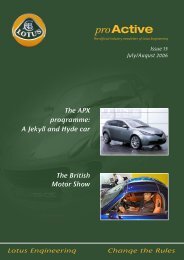Pro Active
Pro Active
Pro Active
Create successful ePaper yourself
Turn your PDF publications into a flip-book with our unique Google optimized e-Paper software.
“<br />
Well-to-‘two wheels’<br />
– a vision of the future of MotoGP<br />
This article, first published in the February 2009<br />
issue of Bike Magazine, is reprinted by kind<br />
permission of its author, Rupert Paul.<br />
It’s lap 18 of the Estoril MotoGP, 2016, and the<br />
Norton rotary, bankrolled by Malaysian renewable<br />
hydrogen fuel giant Petronas, is doing its usual<br />
trick of streaking into the lead for six laps, before<br />
cutting power to ensure it lasts the race.<br />
Luca Rossi, little bro of the old master, is powersliding round in second<br />
on his 900cc V4 two stroke, built by the newly-merged Kawasaki-<br />
Suzuki corporation. There’s not a blue haze in sight, and no expansion<br />
chambers either. Behind him Taylor MacKenzie, son of Neil, could<br />
equal his dad’s best GP placing – on a supercharged Zongshen<br />
bioethanol triple.<br />
Or could he? Triple world champ Marco Simoncelli is closing fast on<br />
his 2WD methanol-powered Yamaha M2. And he’s bringing wild card<br />
Tom Sykes with him, on the Queen’s University Belfast twin-crank,<br />
compound pressure-charged LPG-burning single. But in the end,<br />
Hiroshi Ayoama wins. It’s a blistering day, and his solar panel-faired,<br />
regenerative-braking Honda has been quietly stockpiling energy<br />
throughout the race. On the last two laps the low-revving 2-litre V5<br />
sprouts another 50bhp, demolishing the competition in imperious<br />
style.<br />
This is what racing could be like – a feast of competing technologies<br />
not seen since the 1920s. All it would take is one rule: to limit every<br />
machine to a fixed amount of startline energy.<br />
That’s the vision of world-leading combustion experts Jamie Turner and<br />
Richard Pearson at Lotus Engineering in Norfolk. Although they work<br />
in the car world, their ideas make equal sense for bikes. They’ve spent<br />
their careers researching powertrain technology, and are now trying<br />
to reform the global system of making and regulating cars to head off<br />
the twin horrors of global warming and energy insecurity. Their latest<br />
move is a paper* to reconfigure motorsport, ‘to drive technology for<br />
the betterment of mankind’. Their message? Racing needs relevance.<br />
It has to start reflecting the challenges we face in the real world.<br />
Rationing energy is not entirely a new idea. After all, today’s MotoGP<br />
bikes do their stuff on a 21-litre petrol limit – a principle Jamie and<br />
Richard believe Bernie Ecclestone should adopt. But they also point<br />
out that petrol is only one fuel. There are now cars and bikes out there<br />
that run on diesel, ethanol, methanol, fuel cells, batteries and even<br />
pro<strong>Active</strong><br />
hydrogen. All different forms of energy storage, and litres is no way to<br />
measure them. For that, you need Megajoules.<br />
Turner and Pearson calculate that an F1 car needs about 4784MJ to<br />
complete a race. That means a MotoGP bike, doing 17mpg on fossilbased<br />
petrol, uses 669MJ. And if you specify the allowance that way,<br />
suddenly every powertrain technology can compete on a level playing<br />
field. Top-class racing is transformed into a straight fight for efficiency<br />
– which is exactly what the world needs. Forget Carmelo Ezpeleta’s<br />
decision to scrap the 250s. If he really understood the game he was in<br />
he’d have a 650MJ top class, backed by 400MJ and 200MJ classes.<br />
If the world championship were being set up today rather than in 1949,<br />
that’s what it would look like.<br />
And it needn’t stop there. Energy rationing drives ‘tank-to-wheel’<br />
efficiency for all fuels. Why not also use racing to drive efficiency in the<br />
way different fuels are sourced, manufactured and transported – the<br />
so-called ‘well-to-tank’ stage?<br />
For example, new player Coskata make bioethanol from woody waste<br />
such as straw, leaves and forestry debris. Compared with hauling oil<br />
out of the ground, their process has been independently audited to<br />
emit 84% less fossil carbon. So if a race team used Coskata ethanol<br />
This is what racing could be like – a<br />
feast of competing technologies<br />
not seen since the 1920s<br />
Lotus Engineering<br />
”<br />
rather than gasoline, they ought to be allowed more of it. How<br />
much more? Turner and Pearson’s paper floats a methodology that<br />
would give a Coskata ethanol bike 8.4% more startline energy than<br />
its gasoline-powered equivalent. For corn ethanol it’s 2.9% more,<br />
renewable methanol 10.5%, and renewable hydrogen or electricity<br />
10%. To recognise this, there’d be an energy suppliers’ championship<br />
analagous to today’s manufacturer and team championships.<br />
MotoGP’s 21-litre limit is a good start, but the bikes are still glorified<br />
Manx Nortons. This is a plan that could move the series into the 21st<br />
century.<br />
Source: Rupert Paul, Bike Magazine<br />
Following on in the next issue of pro<strong>Active</strong>, Jamie Turner, chief engineer<br />
of powertrain research for Lotus Engineering will provide more detail<br />
of how energy-based fuel formulae could be applied to future motor<br />
sport.<br />
*Turner and Pearson: The Application of Energy-Based Fuel Formulae<br />
to Increase the Efficiency Relevance and Reduce the CO2 Emissions<br />
of Motor Sport. SAE number 2008-01-2953, presented at the SAE<br />
Motorsports Conference”



